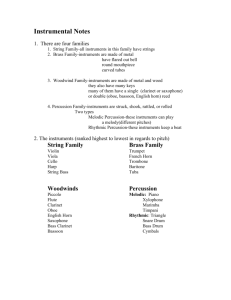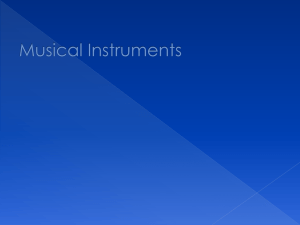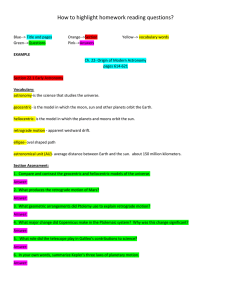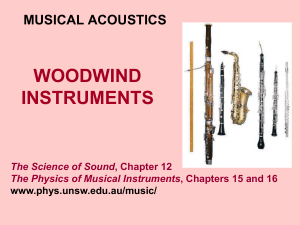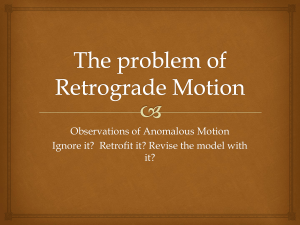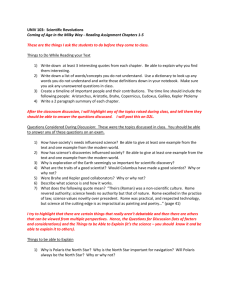FOR WOODWIND QUARTET A CREATIVE PROJECT SUBMITTED TO THE GRADUATE SCHOOL
advertisement
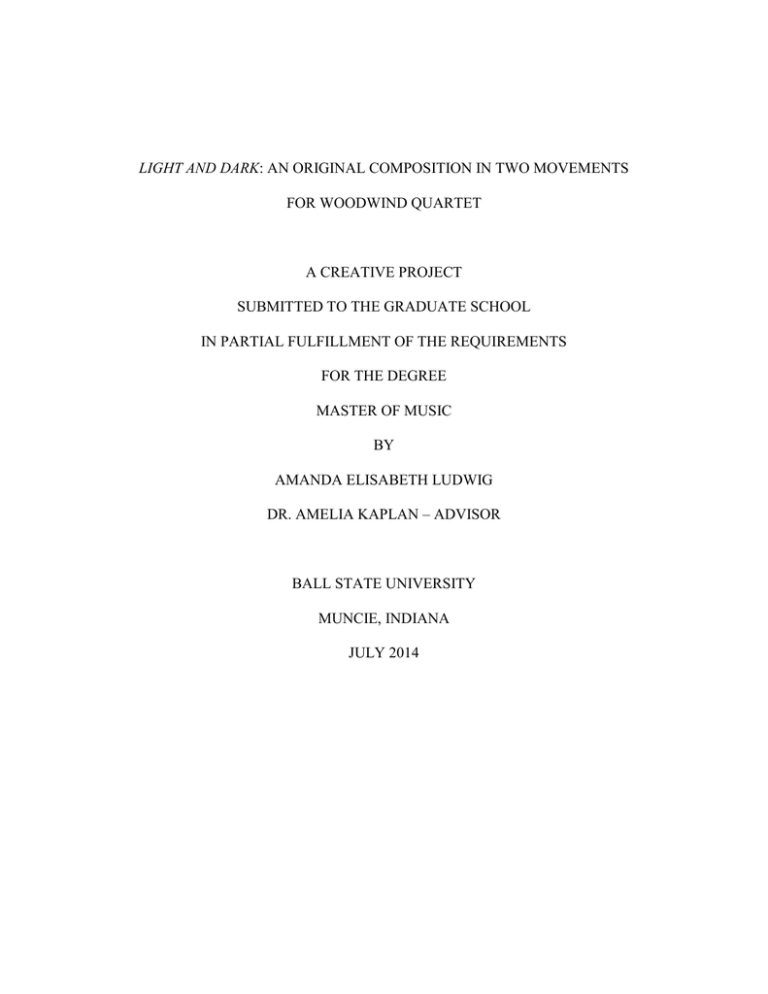
LIGHT AND DARK: AN ORIGINAL COMPOSITION IN TWO MOVEMENTS FOR WOODWIND QUARTET A CREATIVE PROJECT SUBMITTED TO THE GRADUATE SCHOOL IN PARTIAL FULFILLMENT OF THE REQUIREMENTS FOR THE DEGREE MASTER OF MUSIC BY AMANDA ELISABETH LUDWIG DR. AMELIA KAPLAN – ADVISOR BALL STATE UNIVERSITY MUNCIE, INDIANA JULY 2014 1 In the course of describing a work of music I have composed, I often feel compelled to discuss any outside influences on the work. The truth is that my work is far less often influenced by other pieces of music than by virtually anything else. In the case of Light and Dark, a woodwind quartet and my most recent composition, I was motivated to begin after spending several days teaching set theory to a class of undergraduates, making my quartet’s conception more pedantic than inspired. Nevertheless, it is worth examining a few works for similar ensembles by other composers, which I will review briefly before going into more detail about Light and Dark and the ways in which I have both contrasted the titular concepts between movements and created a work that uses retrogrades as a stepping stone to a circular form. The woodwind quartet is made up of a flute, an oboe, a clarinet, and a bassoon, with players sometimes switching to other similar instruments for certain sections or movements, e.g. flute to piccolo. More commonly found in the repertoire is the woodwind quintet, which adds French horn to the list of instruments. Listing all such pieces goes beyond the scope of this paper, but I have chosen to discuss a few specific examples from the repertoire by some wellknown composers. The first piece is by Paul Hindemith, one of my personal favorite composers, although I have never attempted to match his style. His 1922 composition for wind quintet is titled Kleine Kammermusik, or Little Chamber Music. There are five movements, each of which expresses a unique mood, but all of which share the quality of being motivically driven. Many of the motives use a repeated-note pattern in some way, which, depending on the style of articulation being used, can provide anything from a sense of enthusiasm to a feeling of lethargy. The former extreme is found in the first movement in both the primary melody and the related accompanimental figure of two sixteenths followed by an eighth; the latter extreme can be located in the third movement’s slow opening. Of the remaining movements, the second qualifies 2 as enthusiastic, although with less excess than the first. The refrain figure of the short fourth movement is not so much enthused as frantic, and the fifth movement’s heavy accents plant it more within the realm of plodding. It fascinates me that, in the midst of all the difficult rhythms and creative intervallic content for which any piece of Hindemith’s is known, each of the movements of Kleine Kammermusik has a particular characterization, while at the same time using the same repeated-note figure. I mention this particular point because I put a great deal of thought into the articulations involved in the note repetitions found in the “Dark” movement of my own composition. One of the more well-known examples of an actual quartet is Elliott Carter’s 8 Études and a Fantasy (1950), the title of which is a precise and succinct description of the material contained within. The études are short but difficult, often involving highly technical passages that must be played either exactly together or in a precisely staggered rhythm with the other instruments. At the end of the piece is the fantasy, which combines material from the études into a more varied form. There are two études that bear particular mention in my discussion of this work. The third movement is nothing more or less than a D-major chord sustained continually; in the seventh movement, a single pitch G4—as opposed to the pitch-class G—is also sustained continually. I find these études particularly intriguing because of the ways in which Carter creates musical interest while sustaining a single note or chord. In the third movement, the performers shift between different notes of the chord at different times, staggering entrances and remaining close in register to disguise the actual placement of the shifts. The changes are subtle and almost entirely timbral. The fifth movement exploits the timbral shifts and dynamic contrast created by instruments entering and exiting. It too staggers entrances to maintain a sense of continuousness. One of the stylistic aspects I also use frequently in Light and Dark is staggered 3 entrances, and the beginning of the “Light” movement involves subtle entrances on pitches that are already present. My focus on that concept sparked my interest in these particular études of Carter’s. One final woodwind quintet selected for my limited discussion is György Ligeti’s 1953 piece 6 Bagatelles for Wind Quintet. Although the style is very different from Light and Dark, it also differs from the pieces by Hindemith and Carter because it does not typically involve a lot of highly technical, showy passages. The piece is largely characterized by repetitive rhythmic content, much of which is designed to keep both the listener and the player off balance. For example, the third bagatelle utilizes a constant septuplet ostinato underneath a simple melody in three. What makes the movement even more interesting is the fact that in the middle of the movement, two or three instruments play melody lines simultaneously, with one instrument off by one or several beats from the others. Another example is the fifth bagatelle, which uses the rhythm of a sixteenth followed by a dotted eighth so frequently that it becomes difficult to discern the placement of the actual downbeat, especially in the beginning when the oboe, clarinet, and bassoon are playing an ostinato in three under the flute’s melody in four. Although I have only specifically discussed two of the six movements, each one involves interesting rhythmic and/or metrical concepts. Light and Dark does nothing so complex, but I did make an attempt to remain free with rhythm and meter. I did consider the woodwind quintet as a possible ensemble for my piece, but I have never had the same affinity for the French horn as for the actual woodwind family. More importantly, however, the set theory concept that originally inspired Light and Dark is a tetrachord, and I wanted each instrument to be assigned to a specific pitch in the chord. The tetrachord in question is (0257), chosen partly for its lack of minor seconds and abundance of 4 perfect fifths. It is also a symmetrical chord, fitting nicely with the retrogrades present in the piece, and it contains the subsets (027) and (057). Although the two trichords are simply inversions of each other, I noticed that (027) has a distinctly darker quality to it than (057). In that manner, the prime form trichord (027) is similar to the familiar (037), more commonly known as the minor triad. When inverted, (037) becomes the major triad (047), which also has a much brighter quality than its prime form version. Since I already intended to write a piece considering the differences of dark and light, it seemed appropriate to select (0257) as a tetrachord to represent the whole work, and to use (027) for the “Dark” movement and (057) for the “Light” movement. In practice, the trichords and tetrachord have ended up taking on a slightly different role than I originally intended. All three chords are important, but they do not function significantly to characterize the distinction between light and dark. Instead, each chord is used as a section marker within the movements. The set (0257) appears in each movement at the end of the introductory section and the beginning of the conclusion, which, due to each movement being its own retrograde, is merely the introduction in reverse. In “Light,” the defining moment occurs in mm. 13 and 37; in “Dark,” mm. 9 and 33. The (0257) tetrachord can also be considered to mark the only place in either movement that contains material that is not an exact retrograde of pitch. Because of the reasons for this decision, I will return to it during the discussion of my pitch-class choices. (057) appears only in “Light,” at m. 25, while (027) appears exclusively in “Dark,” located at m. 21. Each trichord is used to mark the exact halfway point of its respective movement, making it the turning point of the retrograde. Turning points are also important to the circular form I have designed for this work, which I will discuss in more detail when I explain my formal choices. 5 The actual pitch-classes chosen for the (0257) tetrachord are different for each movement: G, A, C, D in “Light” and G-flat, A-flat, C-flat, D-flat in “Dark.” While the difference may appear at the outset to be merely cosmetic—flat notes being darker than their natural counterparts—the choice of tetrachord pitch-classes was actually based on two distinct and unrelated factors. For “Light,” one of my goals was to create a lot of space between the instruments, but I was also interested in finding the limited area in which all the instruments could be within the same register. Given that the bassoon and bass clarinet are both low instruments and the piccolo sounds an octave higher than written, it was practical to give the piccolo the lowest note of its range, a sounding D5, and to make that the highest note of the chord. The oboe then takes C5, the bassoon A4, and the bass clarinet G4. I did not want to use this spacing more than once in the movement because of the weakness of notes in that register for all instruments apart from the oboe, so I chose to use a much wider spacing for the chord’s first appearance in m. 13. The spacing of this chord is the only nonexact pitch retrograde in “Light.” In the case of “Dark,” I did not choose the notes of the (0257) tetrachord until I had already begun writing the movement. I may even have initially intended to use the same pitch-classes as in “Light,” but the inexorable descent of the scale at the beginning of “Dark” solidified its venture into the realm of flats, and it was as a consequence of the descent that I selected the flat pitches. Because the instrumentation is different from “Light,” it became necessary to give the lowest note, G-flat, to the bassoon, while the English horn takes A-flat, the clarinet C-flat, and the flute D-flat. My decision to alter the octave placement of the pitches in the retrograde was based partly on the fact that I had done so in “Light” and partly on the desire to make the chord more dramatic, so I added more spacing by raising the clarinet an octave and lowering the bassoon by the same amount. Several notes in the flute and clarinet parts around m. 33 have also 6 been altered, the clarinet being placed higher in register to match the m.33 change, and the flute being lowered an octave to avoid obscuring the clarinet. The instrumentation of each movement is based entirely around registral spacing and timbre. I knew early in the composition process that I wanted “Light” to have the opportunity for wide spacing, so I chose to use the piccolo, oboe, and bass clarinet, expanding the range of the ensemble. “Dark” includes flute, clarinet, and English horn, so that there is more overlap and the overall top of the ensemble’s range is not as high as in “Light.” I also made the decision to limit the bassoon to the higher parts of its range for “Light.” This creates a timbral distinction between the movements because, while the bassoon is the lowest voice in “Dark,” the bass clarinet takes that role in “Light.” Similarly, in “Dark” the flute is restricted to the lower half of its range. Although the clarinet is not similarly restricted, its timbre in high registers while combined with a lower-pitched background still has a dark effect; this is most noticeable in mm. 19-23 of “Dark.” The use of piccolo in “Light” also provides a brighter timbre, while the English horn in “Dark” has the opposite effect. In putting together the pitch content of the two movements, I kept spacing, register, and overall patterns of motion in mind. The “Light” movement gradually widens the spacing of the instruments as it approaches the central turning point. The highest note of the piccolo and the lowest note of the bass clarinet are reached simultaneously at m. 21, marking the achievement of the movement’s widest spacing. In the retrograde part of the movement, the spacing decreases, but because the bass clarinet is generally rising in its register, the sense of light is only dimmed, not extinguished. The close-register (0257) chord at m. 37 feels appropriate after several measures of decreasing space, and the bassoon rising to its highest note once more in the ending of the movement provides an appropriate counterpart to the oboe. In “Dark,” I designed many of 7 the melodic figures to emphasize downward intervals in both their original forms and their retrogrades, especially in mm. 10-15 and mm. 27-32. The strongest example of this is the English horn counterpoint with the bassoon in mm. 14-15 and mm. 27-28. Tenuto quarter notes as a backdrop also characterize much of “Dark.” When an instrument is playing the tenuto notes, the lower part of that instrument’s register is emphasized. The ending of “Dark” does become significantly brighter, but because it ends on a perfect fifth interval rather than a chord, it does not feel strikingly out of place. My choice of ending also allows for a smooth transition back into “Light.” One additional motivic concept that informed the development of both movements was the use of scalar figures. The beginning of “Light” features a rising scalar figure in the oboe, which can easily be associated with brightness; I also included rising scales throughout mm. 1524. Starting at m. 26, the scalar figures tilt downward, but the rising registers of the bass clarinet and bassoon, as mentioned earlier, are sufficient to balance out the direction of the motion and thus prevent the movement from feeling too dark. In contrast, “Dark” begins with a descending scale in the flute part, which is emphasized by the downward dragging of repeated whole steps. Descending scales are also important in mm. 16-20, leading into the retrograde. I used a crescendo from mm. 22-26 to make the now-rising scales feel like a push to a goal instead of a goal in and of themselves. The clarinet’s downward motion from mm. 40-41 is used to balance the rising conclusion in the flute. It was not in my original plans for the piece to use retrograde forms for the movements, but at one point while writing “Light,” I realized the beginning reminded me a little of a sunrise. That, in turn, brought to mind the cycle of days passing and sparked my interest in the use of a circular form. The purpose of circular music, at least when I compose it, is to create a piece that 8 can be played multiple times through without stopping, while also sounding seamless. Seamlessness is the major factor in making a piece circular; after all, there is no reason a performance group could not play any given piece multiple times through. The difference in a circular piece is that, while there can be markers at any turning points in the piece, there is some aspect that prevents it from sounding like a distinct end and beginning. In the case of Light and Dark, I use a specific marker for turning points that removes any and all articulations on repeat or reverse. A circular form of this type certainly does not need to be a retrograde to function, but because I used retrogrades within the movements, I have an additional turning point in the center of each movement, mentioned before as the location of (027) in “Dark” and (057) in “Light.” My turning points are designed to be exactly five beats long; there can be up to three notes held over from the previous measure, but the beginning of the five-beat segment must be the point at which the chosen chord is completed. In other words, at least one instrument must change notes at the beginning of the turning point. Similarly, at least one instrument must change notes at the end of the turning point as well, emphasizing the fact that it lasts for exactly five beats. There can be no changes of note during the turning point, but I did allow for some rhythmic interest to lead into the section that follows or out of the previous section. The turning point rules I have just described apply to the beginnings and ends of the two movements, to their central points where each movement becomes a reverse of its first half, and to the points at which the (0257) tetrachord is included in the movement. Although the (0257) points do not function as reversal points for a retrograde or as transitions to another movement or repeat, I treated them as turning points because they are significant to the piece for the same reasons as the (027) and (057) chords emphasized at the reversal points. The initial and final perfect fifth does not represent any significance in pitch choice, but it does represent the sparsest 9 part of each movement, and I have designed it carefully to ensure that instrument changes can be carried out without breaking the continuity of the music. Because of its position as a turning point for both repeats and movement changes—regardless of which movement is in the preceding position—I had to slightly alter the order of time signatures in the retrograde, so that there would be five beats regardless. This also required the placement of an additional bar before the repeat sign at the beginning of “Light” and another after the repeat sign at the end of “Dark.” Ultimately, the design of the beginnings and endings is such that each movement can be repeated on its own as many times as the performers desire before moving on to the next, and the entire piece may be played multiple times without stopping; however, performers should always begin with “Light” and end with “Dark.” The use of retrograde provides an easy way to create a circular form. After all, if the second half of the piece is an exact reversal of the first half, then the piece ends at the same point at which it begins. However, there are numerous difficulties involved in the use of retrograde in a circular piece, especially one that, like Light and Dark, has more than one movement. I could very well have written it such that the second movement was an exact reversal of the first, and I could even have done so using some of the techniques I described to create a sense of increasing light or dark, but I wanted each movement to have a sense of unity within itself and a subtle distinction from its partner. The piece has an unchanging tempo throughout, and the overall style is the same for both movements, but there are different motivic structures based on the light and dark motifs, and the instrumentation and spacing is different. Most of these aspects would not be possible if “Dark” were merely a retrograde of “Light.” My choice was thus to make the individual movements retrogrades of themselves. Consequently, I was able to make each 10 movement circular with itself, and because of the design choices I have already described, I have also made the entire piece circular. A more insidious difficulty involved in the structure of a retrograde movement is that of musical interest. Because of the nature of an exact rhythmic retrograde, which I used for Light and Dark, the natural climax of the piece is often the very center. Both “Light” and “Dark” also have a strong sense of direction, which emphasizes that climax even more. In “Light,” the entire piece is directed towards the wide spacing found at the central turning point, while the center of “Dark” is marked by the point at which the eighth-note scales change from descending to ascending. Although I wanted to use an exact rhythmic retrograde and a near-exact pitch retrograde, I did not want either movement to make its final climax at the central turning point, so I made the decision not to follow the retrograde format when designing my dynamics and articulations. I believe this is an important decision for any composer of a retrograde form to consider, because melodies played in reverse may have a natural emphasis in a different place. It was the sense of emphasis and phrasing that guided my articulations, as well as a desire to make sure all the players had plenty of opportunities to sneak breaths whenever necessary. The dynamics were the more important aspect in altering the climax point of each movement. “Light” begins with a gradual crescendo that becomes more insistent as the piece approaches the central turning point, but the actual dynamic climax is in m. 29, several measures later, after a few false climaxes between mm. 21 and 26. After that, there is a dramatic diminuendo in all parts, but the piece ends with another crescendo in the oboe and bassoon, allowing for a different dynamic start to “Dark.” I chose to begin with a diminuendo in “Dark,” but it is soon followed by a gradual crescendo, making the overall dynamic of the first part of “Dark” stronger than that of “Light.” The first climax point is at m. 20, just before the central turning point, but I allowed the 11 rising scalar figures after that to lead into a second climax at m. 27, and then I used the melodic section to drive towards the final, most significant climax at m. 31, which sustains for a few measures before leading into a dramatic diminuendo that ends the piece on a quiet note or else leads easily back into “Light.” Although I did not take inspiration directly from any previous composers or pieces for woodwind quartet or quintet, I feel that Light and Dark represents a significant accomplishment for me as a composer. My work may not be as technically or rhythmically difficult as the pieces I examined by Hindemith, Carter, and Ligeti, but I think it presents its own challenges and will encourage performers to think carefully about the best way to make it work. I also think Light and Dark is my first true foray into the types of musical sounds and forms that truly represent me as an individual composer. 12 REFERENCES Adler, Samuel. The Study of Orchestration. Third Edition. New York: W.W. Norton, 2002. Carter, Elliott. 8 Études and a Fantasy: for Woodwind Quartet. 1950. New York: Associated Music Publishers, 1959. Hindemith, Paul. Kleine Kammermusik, op. 24, no. 2. 1922. Mainz: Schott, 1922. Ligeti, György. 6 Bagatelles for Wind Quintet: aus Musica ricercata. 1953. Milwaukee: Hal Leonard, 1973.
